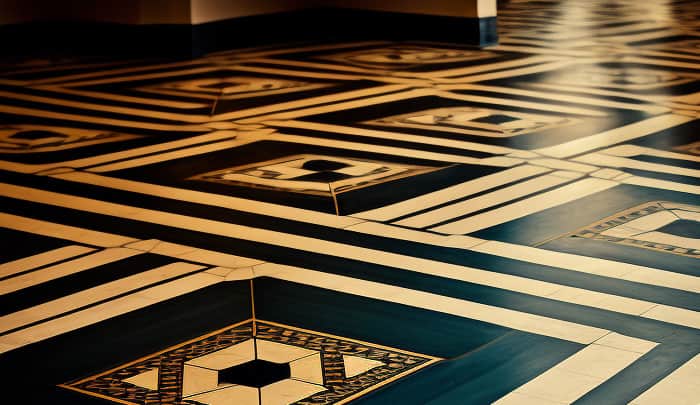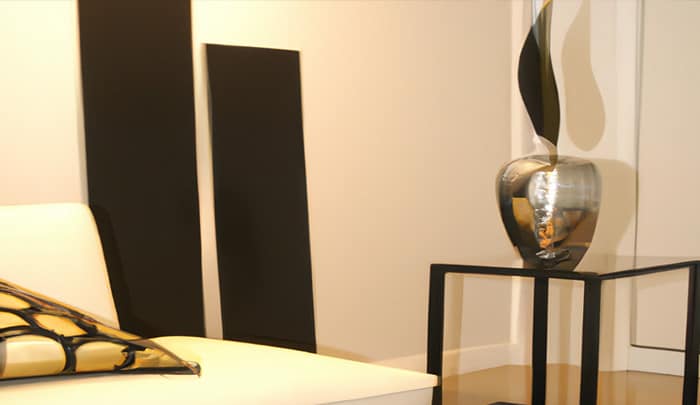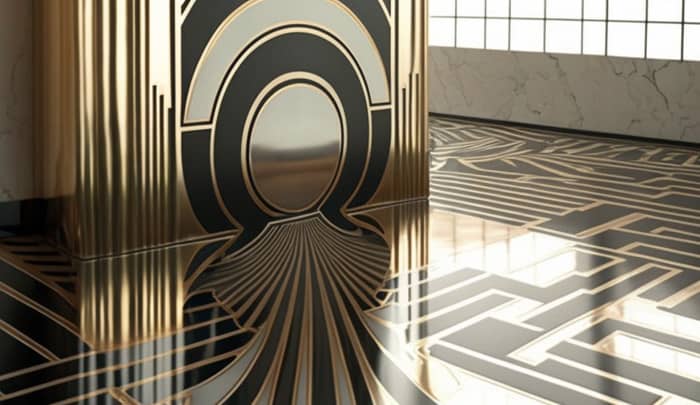
Are you an avid fan of art deco and vintage style? Good news — you don’t need to scour the antique shops and flea markets for statement pieces, you can easily transform your home with a timeless look, just by installing art deco flooring.
Sleek and modern yet oozing classic sophistication, art deco flooring can take your home to the next level of glamor and versatility, with little effort. Whether you have a modern or traditional home, or something in between, art deco flooring can lend the perfect touch of uniqueness while making your decor look more elevated, in just a few easy steps.
Read on to learn more about art deco flooring, the options available, and how it can help you achieve the look and atmosphere you desire. With the right style, it won’t take much to give your home an entirely new, fashionable look.
You can find many companies that offer Art Deco flooring online or in home improvement stores. Make sure to compare prices and read customer reviews before making a purchase to ensure you are getting the best deal.
“Integrating Art Deco flooring into your existing design requires a thorough understanding of the period’s geometry and symmetry. With the right choice of vibrant patterns and streamlined shapes in your flooring, you’ll not only pay homage to this wondrous era but elevate your living space to an unparalleled aesthetic experience.”
Priscilla Juniper, Art Deco Specialist
Understanding Art Deco Flooring
Art Deco flooring is a stunning and timeless choice for transforming your home into an elegant space. The seamless blend of Art Deco style and contemporary design lets homeowners create beautiful and unique pieces that reflect their individual personalities. Before deciding on flooring options for your own home, it’s important to understand what Art Deco flooring is and how it can be used.
Put simply, Art Deco is a distinct style of architecture and design originating in the 1920s and ’30s. Characterized by bold geometric shapes and color palettes, as well as angular designs and motifs inspired by Egyptian, Aztec, Greek and Roman culture, this style has been gaining popularity again in recent years.

When it comes to floors, elements like herringbone patterns, strong geometric shapes, angular lines, repeating patterns and bright colors are all typically associated with Art Deco aesthetics. These patterns can even include pink flooring ideas for those seeking a bold and unique look. This has led some homeowners to view Art Deco floors as overly ornate and overwhelming for a modern home décor. However other homeowners see them as a perfect reflection of classic elegance in the modern era. Quite the opposite of the Japandi Style.
Regardless of personal tastes in interior design, one thing’s for sure: an Art Deco floor adds character and charm to any room while also capturing a timeless look. Now that we understand the basics of Art Deco flooring, let’s take a look at the components that make up an Art Deco floor in the next section.
Components of an Art Deco Floor
Art Deco flooring is a distinctive design that adds timelessness and character to any home. Created by the famous French designer, Emile-Jacques Ruhlmann in the 1920s, this unique style features geometric patterns and luxurious materials. When undertaking an Art Deco flooring project, there are several components to consider.

Surface Material: The material of your flooring has a substantial impact on its durability and aesthetic appeal. Typical options include marble, parquet wood, concrete, mosaic tile, and terrazzo. Marble is well-known for its ornately carved designs and beautiful veining. It is also one of the most expensive materials available, making it a luxury choice for high-end applications. Parquet wood comes in different sizes and shapes such as herringbone, chevron, and basket weave. It is substantially more affordable than marble but still offers elegant visuals. Another option is terrazzo tile which consists of poured concrete with colorful glass chips embedded within it to create a unique patterned look. No matter what type of flooring you choose from these materials, be sure to seal it with an appropriate sealant product to protect it against stains or spills over time.
Layout: Layout plays an important role in determining your Art Deco floor’s overall appearance. Common designs feature repeating patterns or concentric circles that draw the eye toward your room’s center point or focus area. Clever layout choices can even make a room look bigger. You can achieve symmetrical layouts by carefully placing tiles, maintaining tight joints between pieces, and framing out distinct sections with contrasting accents like darker grout lines or indented inset borders. For asymmetrical layouts—where repetition isn’t necessary—you can combine different materials, angles, or textures to create an eye-catching pattern that may curve outward from the center point like ripples on water.
Transitions: Carefully choosing transitions between your floors and adjoining surfaces can ensure that movement between rooms appears natural – even if those surfaces have different materials! Transitions should blend harmoniously into the large-scale design without interrupting the flow of traffic from one room to another; consider using recessed thresholds at doorways instead of abrupt step up/step down changes from surface to surface when possible. Additionally, though not always necessary depending on surface materials used (for example carpet won’t need transitioning), installing coved transitions along edges where tile meets wall can be a great way to add additional visual interest while maintaining a smooth continuity of flooring material throughout your home!
As you select components for your Art Deco flooring project, the importance of aesthetically pleasing and durable surfaces cannot be understated – after all they will set the stage for years worth of enjoyment! With careful consideration of both surface material choices and layout plans you will be able to create a beautiful space in keeping with this timeless classic design style that guides your daily routines as well as enriches your home’s decor overall.
Having carefully considered both aesthetic appeal and durability when selecting components for your Art Deco flooring project, let’s now turn our attention to exploring the historical significance behind this distinguished design style. In the next section we will discuss how this unique style came about and take a deeper look at different elements that contribute to its enduring popularity!
Key Takeaway
Art Deco flooring is a unique design style originating from the 1920s created by French designer, Emile-Jacques Ruhlmann. When selecting components for an Art Deco flooring project, the material of your flooring, layout, and transitions should all be taken into consideration to achieve a timeless and elegant look. Additionally, exploring the historical significance behind this design style will help you appreciate its distinct characteristics and understand why it remains popular today.
Historical Significance of Art Deco Flooring
The historical significance of Art Deco flooring lies in its unique combination of materials and design elements from various culture influences. Originating in the 1920s, Art Deco is often referred to as a mixed-period style because of its blend of geometric, floral, and abstract motifs from a variety of cultures and time periods, including Egyptian motifs, Greek Key designs, Medieval artistry, and even classic French furnishings. These design elements work together to create a look that is simultaneously bold and timeless.
Today, these flooring tiles are treasured and coveted for their uniqueness. They add character and style to any space while still feeling modern and comfortable. Additionally, they can be used to restore an older property or to refresh a room with a whole new look. Art Deco floors can instantly evoke a vintage feel all while being incredibly flexible, enabling them to match many different types of existing furniture or home décor.
There is some debate over whether Art Deco tile should be used in modern spaces or if it should stick to more traditional rooms. Those in favor argue that if done tastefully, you can use Art Deco tile even in contemporary settings where it may be juxtaposed with chrome, glass, and steel accents for an eye-catching contrast. Those opposed claim that the modern technology used to make Art Deco tiles does not represent the original materiality as much as hand-painted artisanal flooring does.
No matter which side of the debate you may stand on, one thing is certain: Art Deco flooring has stood the test of time and has undeniable historical significance. As you continue reading, learn more about how the style evolved into modern trends during the 1930s.
Art Deco Trends in the 1930s
The Art Deco era began in the 1920s, but the popularity reached its peak during the 1930s. This style of flooring while still modern and contemporary embodied classic, simple, yet elegant lines that created a timeless look. Art Deco trends of the 1930s included incorporating minimalist and geometric shapes, utilizing bold colors and contrasting materials, as well as designing with classic motifs. While all of these elements can be seen in Art Deco flooring today, back then this style was revolutionary and sought after for how unique and distinctive it was.
The debate surrounding art deco flooring from the 1930’s still persists today. Many claim that the nostalgia behind this timeless trend cannot be rivaled or replicated by bulk produced options available now, making it a classic must-have for their home design. Others argue that mass production has made this style more affordable without sacrificing quality, making it accessible to anyone who wants to add that special something to their space.

Whichever side you may find yourself on, Art Deco flooring remains one of the best ways to transform your space into a timeless statement. Next we’ll discuss different types of Art Deco flooring you can use to achieve this look.
Different Types of Art Deco Flooring
One of the primary benefits of art deco flooring is that it comes in a variety of styles and materials, so you can find something to match any décor. Ceramic, porcelain, glass, and stone are all popular choices, as they often mimic the bold and intricate designs found in traditional Art Deco style. Wood flooring is also an option, but some debate whether it’s true to the aesthetic; while wood might look great with a minimalistic Art Deco design, it may be too modern and therefore conflict with a more classical motif.
Linoleum is a surprisingly stylish choice for flooring with an art deco edge. It has come a long way over the years—many modern linoleum products have a marble-look and are designed to imitate natural stones—and its versatile nature makes it easy to customize and install on any type of subfloor. Vinyl is another viable option due to its affordability and endless color and pattern options.
Metal tiles, on the other hand, will give your home an edgy industrial look reminiscent of the machine age’s attitude towards modernism. While metal tiles can be difficult to maintain over time due to their non-porous surfaces, they are quite durable and provide good insulation against radiant heat transfer. Plus, their sleek designs make them perfect for achieving simple yet dramatic effects.
No matter what type of flooring you choose, there’s no denying that transformations through art deco materials can be truly stunning. With careful consideration of color and texture choice, you can create a unique living space that honors the aesthetics of vintage styling with a contemporary twist.
This section has discussed the different types of art deco flooring available today; however, we haven’t addressed how trends in art deco design are now expanding beyond surface materials into installation techniques themselves. The next section looks at how advances in art deco designs are giving homeowners even more opportunities to bring timeless beauty into their homes.
Advancing Art Deco Designs

The appeal of Art Deco designs has grown significantly in recent years, with a variety of modern adaptations of the timeless style available in both interior and exterior applications. Advancing these designs to create a contemporary look for homes has been accomplished with great success, opening up doors to many creative possibilities. When implemented properly, this approach can convey an exciting blend of historical tradition and modern appeal, while achieving a unique aesthetic that stands out from the crowd.
One compelling argument in favor of advancing Art Deco designs is that they provide a way to keep up with fashion trends while borrowing from traditional elements. For homeowners looking to give their home a touch of sophistication, there’s no need to go overboard when it comes to décor or furniture—simply incorporate some subtle Art Deco flooring pieces and you’ll instantly add style and character. This approach allows you to maintain the classic elegance of older interiors without sacrificing your own flair for modern design.
On the other hand, some may find transitioning into modern Art Deco designs challenging due to its starkly different aesthetic from the traditional style. Without careful consideration given to selections of materials, colors, shapes, and sizes, the results may come off as disjointed or outdated rather than stylish and contemporary. As with any other design choice, it all comes down to personal preference and attention to detail—achieving an attractive outcome requires thoughtful planning and execution, which may be too involved for those who don’t have a keen eye for interior design.
Regardless of whether you choose to move forward with advancing Art Deco designs or remain faithful to its original form, there’s no doubt that incorporating this timeless look provides an appealing twist on your home décor. Combining classic elegance with modern innovation can take any space from plain-looking and bland to chic and glamourous in no time—the possibilities are endless! The following section will look at how incorporating contemporary flooring aesthetics can take your home décor to the next level.
Contemporary Flooring Aesthetics
When it comes to contemporary flooring aesthetics, there is a great deal of debate amongst homeowners and designers alike. Some prefer the timeless look of Art Deco flooring, while others prefer more modern styles, such as contemporary hardwood or tile. The right flooring style can take any space from dull to delightful; however, picking the wrong one will leave you with a poor design.
On one hand, modern tiles and hardwood offer numerous options when it comes to color and texture. They can be customized to fit any interior theme from classic to eclectic, making them an excellent choice for transforming a room’s aesthetic. Additionally, these types of flooring are very easy to maintain and often last for many years without needing refinishing or replacement.

On the other hand, Art Deco flooring provides a sense of history and beauty that cannot be matched by it’s modern counterparts. The intricate designs found in Art Deco products create fascinating patterns that add interest and charm to any home. While they may be more expensive initially and require more maintenance than modern styles, they can provide a timeless elegance that stands out from the crowd.
Ultimately, it comes down to personal preference when choosing between modern and vintage flooring aesthetics. Both offer distinct benefits that can help bring your design vision to life – all you need to do is determine which one best suits your needs and style preferences!
Common Questions Answered
How does art deco flooring compare to other flooring styles?
Art Deco flooring offers an enduring, stylish look to any home. It is distinguished by its bold colors, geometric shapes and striking lines. Compared to other flooring styles, Art Deco stands out for its grandeur and flair. It creates a stunning visual impact that cannot be achieved with other types of flooring. Besides the aesthetic appeal, Art Deco flooring is also incredibly resilient. Its hard wearing surface can last for decades if it is properly maintained. This makes it an excellent choice when considering long-term value for your home.
What materials make up art deco flooring?
Art Deco flooring typically consists of geometric shapes, intricate designs and motifs, and bold colors. Common materials used are terracotta, ceramic, stone, marble, granite, slate, mosaic, limestone, terrazzo, and even wood. However, the most essential material when it comes to art deco flooring is tile. That’s why you will often see art deco style in kitchens and bathrooms – a great way to make a lasting statement! Because tiles can be crafted from different materials and finished with a variety of colors, designs and textures, they make it easy to create an entirely unique look. The key is personalizing the space with unique elements. Whether you choose to incorporate rare stones or earthy hues – art deco floors can bring character and sophistication to any room.
Where can I find unique art deco flooring options?
If you’re looking for unique Art Deco flooring options, you have plenty of options available to you. For starters, there are many vintage flooring stores, either online or in your local area, that specialize in salvaged and reclaimed Art Deco styles. At these stores, you’ll find a wide selection of one-of-a-kind pieces that range from handcrafted tiles to exotic woods. Additionally, it’s important to also check out modern manufacturers who craft their own pieces inspired by the classic Art Deco style. Many retailers offer designs that combine traditional motifs with modern artistry, allowing you to achieve a timeless look while still embracing current trends. Finally, if traditional store shopping isn’t your preference, sites like Etsy allow you to explore one-of-a-kind flooring options crafted by independent artisans from around the globe.





I opted for Art Deco flooring in a recent restoration project and the results were sensational. The design, despite being vintage, added a sleek and modern look to the property. It’s a style choice that has multi-faceted appeal, suiting both traditional and contemporary homes.
Pairing Art Deco floor styles with matching era furniture and accessories can indeed create a distinctive, vintage feel. I agree with you, Farah, the versatility and timeless appeal these pieces bring to both traditional and contemporary spaces is unmatched. In my home, visitors never fail to notice and appreciate the unique blend of historic and modern aesthetics.
I’ve personally found that combining art deco flooring with some strategically placed art nouveau elements can add an unexpected, yet harmoniously blended vintage charm to your space. In my living room, an original ornamental art nouveau fireplace paired with my geometric patterned art deco flooring never fails to catch eyes.
I always perceive art deco flooring as the silent focal point, an elegant understudy in a theatrical play. It allows other retro elements to shine, yet when its moment comes, it never fails to capture the spotlight.
The moment I installed an art deco flooring in one of my restoration projects, TV set designers started calling me wanting to use that house as their shooting location.
As an interior designer specializing in historical restoration projects, I can vouch for the use of art deco flooring as it can genuinely redefine the entire ambiance of any area in style.
As someone who’s recreated vintage art deco furniture from their blueprints for many years, I’ve learned to appreciate the intricate details and craftsmanship required. While I mostly work on smaller items, I can only imagine how transformative art deco flooring would be in any property. The sleek lines and ornate details would create an entirely new atmosphere, one filled with class and elegance.
Art Deco flooring transformed my own home like salt brings out the flavor in food – it simply wouldn’t be the same without it. The intricacy and timeless elegance it provides made every corner of my house engrossingly distinctive, instantly adding a magnetism that other styles often lack.
I’ve used art deco flooring for a recent project on a classic Victorian home – it subtly breathed life into the antiquated structure. It’s like pouring an aged wine into a fresh glass; the taste remains, but it feels revitalized.